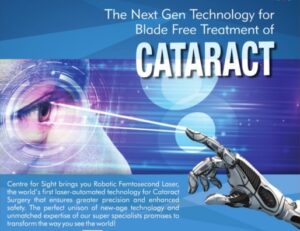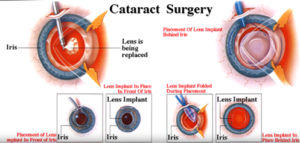Robotic cataract surgery is the next gen technology for blade free treatment of cataract.


Common Symptoms of Cataract
It all starts with the development of cloudy vision. You will start to have blurred vision. Also, some of the other common symptoms include: Developing halos around lights, double vision, sensitivity to light and glare, difficulty in seeing at night, fading or yellowing of colours and frequent changes in prescription glasses.
Traditional Cataract Surgery
Also known as phacoemulsification. In this kind of surgery, the surgeon creates a small incision in the cornea. After creating a small opening in the eye capsule, the surgeon inserts a pen-shaped probe into the eye-opening. The probe gives out sound waves that break up the lens. The broken pieces are then suctioned out. The lens is then replaced with an artificial IOL lens.
About Robotic Cataract Surgery
Cataract surgeries will become faster and hassle-free with the new technology that uses laser systems to operate on cataract patients. Also known as the robotic cataract surgery, this technology uses a femtosecond laser machine which is docked on to the eye. Images of the eye are then captured by an imaging system attached to the computer.
The incision of the cornea, the opening of the lens capsule and fragmentation of the lens is done robotically. The robotic step of the cataract surgery is performed in less than 30 seconds. Here is a medical guide that explains the benefits associated with the robotic cataract surgery:
1. High Precision : Sharp precision is not possible in all cases while removing cataracts manually. With the introduction of robotic cataract surgery and computerized laser systems, surgical risks like poor quality incisions and a capsular tear running out of control are reduced to a significant extent. It guarantees a considerable degree of accuracy, and it is beyond what a human hand can do.
2. Perfect Lens Placement & Alignment: The robotic laser makes a precise central opening on the lens bag, ensuring a stable bag and well centered artificial lens at the end of the procedure.
3. Laser-Assisted Correction: Laser-assisted Vision correction –Robotic laser can correct cylindrical number to some extent with Laser incisions, a process not possible with manual surgery.
4. Better Visual Outcome: The robotic cataract surgery offers the restoration of clear and sharp vision and guarantees the removal of cataract and cloudiness. As opposed to manual cataract surgery by a surgeon, robotic surgery guarantees more effectiveness and sharpness as it reduces human intervention and works on calculated incisions.
5. Faster Recovery: There’s quicker recovery with robotic cataract surgery, and it is an excellent option to consider for patients seeking comfortable recovery and faster recovery.
Tips to minimize recovery time and complications:
1. Don’t drive on the day of the surgery or refrain from driving for a few days.
2. Avoid swimming, getting into hot water tubs to minimize the risk of infection.
3. It is recommended to avoid activities like lifting heavy objects and bending for a few weeks.
4. Don’t do things that will create unnecessary pressure in the eye.
5. Don’t rub your eyes immediately after the surgery. You might feel itchy eyes for some time but it is normal.
6. Don’t expose your eyes to dust, water, and dirt as these are irritants and might increase the risk of developing complications.
7. Do take your doctor’s prescribed medications and eye drops.
8. Wear black-framed glasses for some time to protect your eyes from direct light.
Are you eligible for robotic cataract surgery?
You are mostly suitable for robotic cataract surgery unless your case is complicated or under few instances of a non- dilating pupil, you are not eligible for a laser cataract surgery. Else, if you have a hard, matured or subluxated cataract laser cataract seems to be the best alternative and provides sharp vision. Also, if you have a cataract in both the eyes, it is advisable to operate the one first that is in worse condition. Though it is possible to operate both cataracts in one go, your eye surgeon will recommend you after weighing the pros and cons.
How to prevent cataract?


1.Maintain a nutrient-rich diet: It is very important to incorporate foods that are rich in antioxidants like vitamin C and vitamin E enriched foods. Fruits like orange, lime and kiwi are a source of vitamin C. For vitamin E, use vegetable oils like sunflower, safflower, or wheat germ. Eating nuts, especially almonds provide a good source of vitamin E. So do peanuts. Also, green veggies like spinach and broccoli and cereal contain extra vitamin E.
2. Avoid smoking: Smoking produces free radicals that can harm your eyes. Radicals are chemicals that harm the cells in the eyes and destroy the good chemicals in your body. To prevent cataract it is best to quit smoking.
3. Control Diabetes: People with diabetes are more likely to develop a cataract. Therefore it is important you keep it under control.
If at any point you experience symptoms like cloudy vision, do schedule an eye examination. Delaying treatment can increase your chances of getting a complicated surgery.


Dr Mahipal Singh Sachdev-Chairman
Centre For Sight











